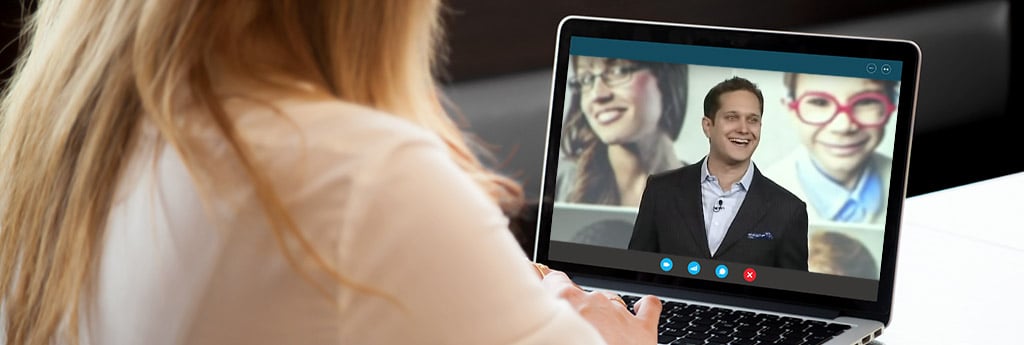Virtual Events: Five Frontline-Tested Insights to Deliver Outstanding Virtual Presentations

Delivering outstanding virtual events is critical for leaders, meeting planners, event sponsors, marketers, and participants. Now, as every industry, organization, and company is feeling the impact of the COVID-19 pandemic, virtual events have moved from a luxury to a necessity. The imperative for delivering excellent virtual events will only continue to grow as leaders strive to engage all stakeholders across geographies.
I understand that virtual events can be a challenge for even the most experienced event organizers, stakeholders, and participants. As a generational keynote speaker, I’ve been advising and participating in virtual presentations and events for many years. In fact, in 2019, over 100,000 leaders from 100+ countries video streamed a keynote speech that I presented at GLN. This type of work is a passion for me because virtual events and virtual presentations are a great format to bridge and engage generations, leaders, and geographies. Below are my Top Five Frontline-Tested Insights to produce and deliver fantastic virtual events.
Five Frontline Insights to Deliver Fantastic Virtual Events
#1 – Bring the Energy and Positivity
Right now, many people participating in virtual events may feel like they’re stuck on their own island, including the virtual presenters. These participants may be quarantined in their own home while trying to work, participate in the virtual event, and navigate home school for a nine-year-old. This new reality makes virtual events even more important and urgent as a powerful, meaningful, real-time way to bring people together for inspiration, learning, alignment, and more. These events offer a time to connect, collaborate, share, learn, create community, and prepare to take action. Creating these kinds of interactive learning and engagement opportunities is a necessity, especially in these difficult times.
As tough as it can seem during these times, it’s incredibly important for event hosts, emcees, and presenters to remember to smile and bring the energy! Yes, topics may be serious, and conversations will be tough, but we’re not giving up. We’re moving forward—and it takes energy to move forward, especially now. So, remember to bring the energy during your virtual presentation and event! We’re all in this together, even though we may be physically separated. Bridging this divide is exactly what fantastic virtual events deliver!
#2 – If the Virtual Event Is Live, Have a Back-Up Technology Plan Ready
Technology can be finicky—even in the best of times and situations. What works well in a test run may not work well or at all during the live virtual event. It happens to all of us. In addition to doing at least two tests runs with all the technology you plan to use for your virtual event, we find it’s important to have an agreed-upon back-up plan in case something happens.
If the presenter has technical difficulties, such as the audio, video, or slides not working, identify ahead of time who will step in to fill the time for the presenter to log back in. If participants have technical issues, have a plan for who they should contact during the event for a rapid reply—and let everyone know upfront and in the chat. The plan should not be to bombard the presenter with technical questions but to have someone else available to step in and help right away. Assuming elements won’t work is the best way to be prepared and reduce stress for everyone during the virtual event—even if everything goes according to plan.
#3 – Adapt In-Person Presentation Styles for Virtual Presentation Delivery
I have delivered thousands of presentations in-person, but what works with in-person keynote presentations on a huge stage for 10,000 leaders or in a corporate boardroom for 11 executives doesn’t necessarily work for a dynamic virtual presentation. Based on years of experience presenting virtual events to audiences around the world, I’ve found that, in general, virtual presenters should plan to cut their speech down by 20 to 25% to make it much tighter. In addition, virtual presenters should adapt their traditional presentation to include virtual engagement elements such as participant polls, live Q&A, breakout rooms, pre-event content, and other ways to engage participants with the presenter and each other digitally.
#4 – Develop A Post-Virtual Event Take-Action Plan
Virtual events are similar to in-person events in that they often happen once and then are over. A one-time virtual event is excellent for driving an emotional response, creating buy-in, awareness, alignment, and initial learning. But like all one-time events, the impacts can be limited or fade without planned reinforcement. I have found that the best way to achieve tangible, measurable results from a Virtual Event is to have a clear take-action or reinforcement plan before you kick-off the virtual event.
If you’re hiring virtual speakers, such as myself or other speakers at The Center for Generational Kinetics (CGK), make sure that all presenters agree upfront to provide reinforcement videos or Zoom follow-up meetings to dive deeper and reinforce the content over the next 30, 60, and 90 days. If the presenters are from your in-house team, record the reinforcement content right after (or even before!) the virtual event, and use automation technology to start emailing the reinforcement content right after the event. The more reinforcement you provide, whether pre-recorded or go-deeper live Q&A, the more the content of the virtual event will stick and translate into action.
#5 – Create a Virtual Event Strategy Playbook
Too often, there is a temptation to pick up the playbook from in-person events, such as annual meetings or conferences, and try to adapt it for virtual events. Doing this sounds efficient but often leads to all kinds of challenges. It’s like taking a van and deciding to make it a convertible—you could do it, but the result may not be pretty. Instead, start with a blank slate and answer these virtual event strategy questions:
- Who will be participating in the virtual event?
- Will they be participating by laptop, tablet, mobile, or all three?
- What type of engagement do we want from virtual presenters, hosts, and participants—before, during, and after?
- What are the key learning outcomes we need to achieve?
- What type of promotion will most energize potential participants before the event?
- What are the key topics that we need to make sure and cover to achieve the learning results we need to move forward during this unprecedented time?
Taking this first step will position you for a successful virtual event, from the ground up!
My team and I at CGK are here to help you with your virtual event.
If you believe an outstanding virtual event can help you and your organization drive learning, leadership, sales, motivation, and results during these challenging times, contact my friendly team here.
I can deliver one of my highly interactive virtual presentations or provide trusted insight into the best practices we’ve gained from our 10+ years of online learning and engagement experience. I am happy to share what we’ve found works best and the different virtual presentations that can be customized and delivered for clients around the world—including pre-event promotion and post-event reinforcement.
We are all in this journey of learning, growth, resilience, and re-emergence together, and that is not a virtual commitment from me—but the real deal!




